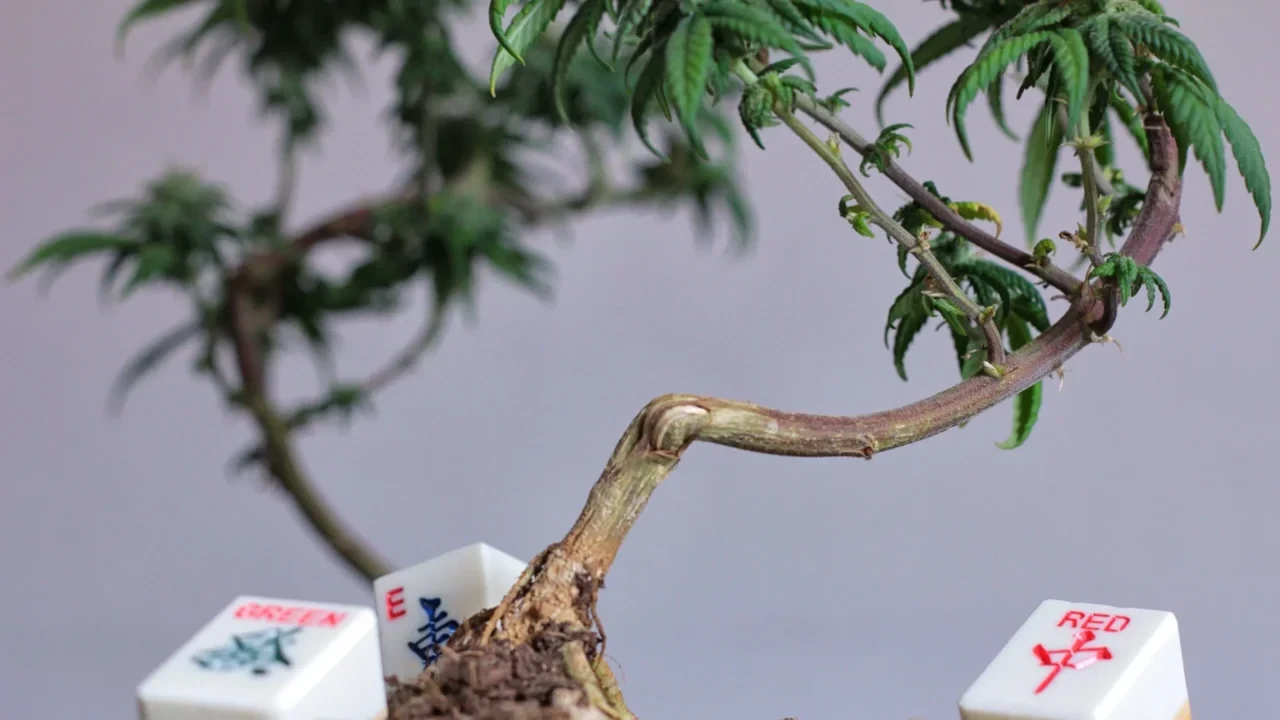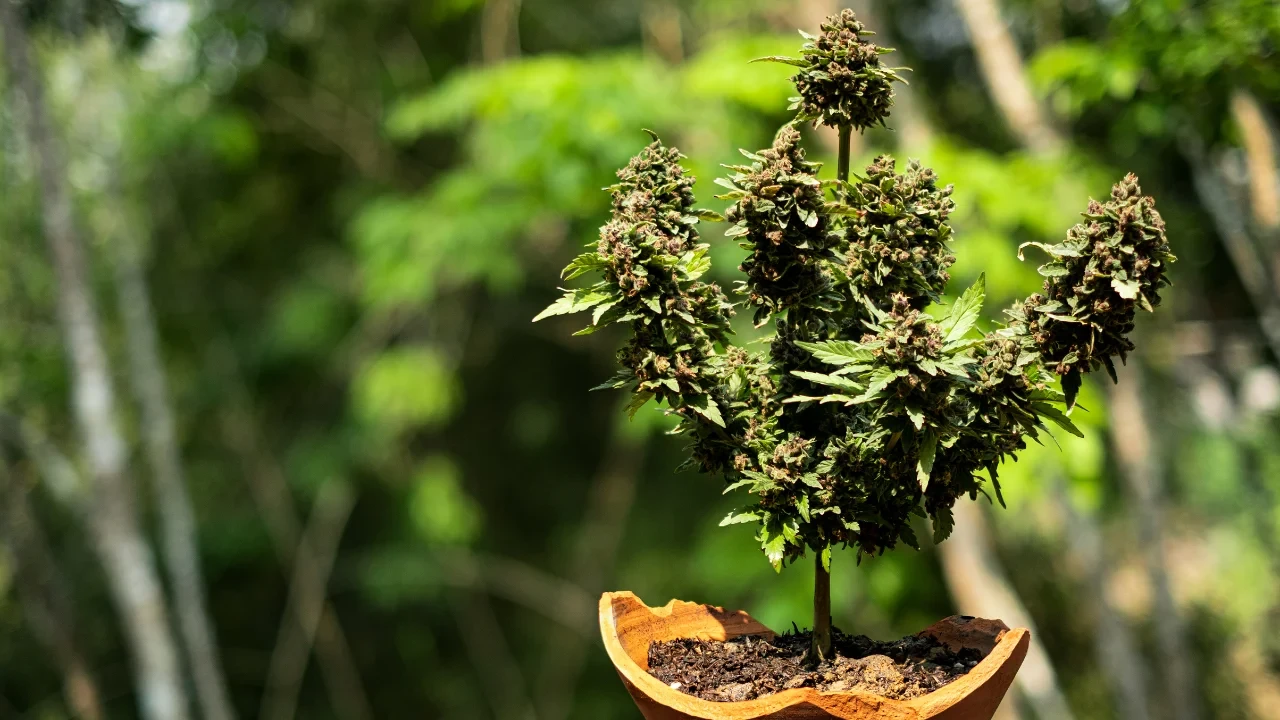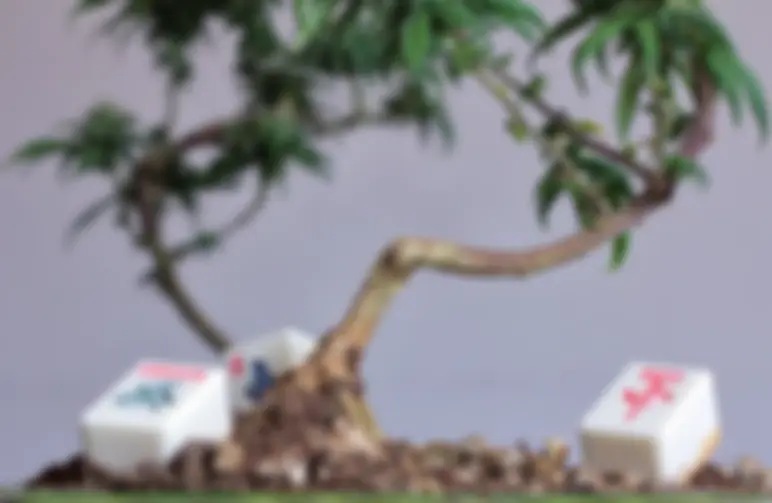Bonsai weed plants are neither myth nor legend. They are very real and fun ways to cultivate a good-looking potted strain. After all, bonsai simply means “planted in a container” in Japanese and refers to any tree-like scenes that can be kept sustained in a small pot.
Bonsai originated in ancient China and was brought to Japan, where it developed as an art form and hobby for the elite. You can even find living bonsai today, dating from the 17th century.
Just like the ancient Japanese bonsai trees we all love, cannabis can also be grown in miniature to be aesthetically pleasing through pruning and trimming. Here, we look at how to get started with this cannabonsai trend.
With our guide, you'll have no problem cultivating a handsome bonsai plant that can be kept as a mother plant for years to come or simply treasured for its aesthetics.
Bonsai Cannabis: what is it?
Bonsai cannabis, or cannabonsai, is a popular trend among weed aficionados and aesthetic gardeners. It’s the art of planting and sustaining a simple cannabis strain in a pot and pruning it into pleasing shapes and sizes.
As the goal of bonsai in Japan (or Penjing in China) is to grow a gorgeous-looking tree to maturity in a tiny container, so too cannabonsai sustains cannabis plants through clone clippings.
Where cannabonsai really comes into its own is in maintaining genetic variation for a cannabis garden. You can utilize the small potted format to generate diversity through mother plants without having to sow seeds.
However, there’s no denying that there’s an aesthetic art to bonsai. This is where the trend comes in.

The idea behind Cannabonsai
More than just generating clone clippings for cultivation, cannabonsai is about training your plant to grow in spectacular ways. That means you can just keep it simple with miniature Christmas w-like shapes, but the more fun route means aiming for more experimental appearances with off-shoots.
Bonsai Cannabis, a new trend?
The first cannabonsai tree is hard to pinpoint. People have been keeping mother plants for decades. Seasoned cannabis growers gravitate towards strong plants, which they keep in a vegetative state to produce clone clippings for future crops.
These, however, tend to grow big, not small. Trimming them for aesthetic and compact purposes, however, can be traced back several decades or so ago, when images began to circulate on internet forums.
At first, people thought it was a hoax. Many fake photoshopped images were indeed distributed with cannabis in impossible shapes and sizes. But some were real. The trend hit off and has been perfected among aficionados over the years.
Given that bonsai simply refers to growing a plant in a small container, a simple potted cannabis plant surely fits the bill as well.
Whatever style you go for and for whatever ends, the cannabonsai has become a solid talking point in the online community and has swept across Instagram with clever tags like #budzai, #cannabonsai and #bonshigh.
With some training and patient pruning, you can achieve the same iconic twisted branches and miniaturized aesthetics of the iconic Japanese bonsai trees. Get started with this subtle art by following these handy tips.
How to make a bonsai weed plant?
1. Gather materials
To grow your weed bonsai tree, you’ll first need a young cannabis plant or seedling that’s ready to pot. You’ll also need a few materials for both preparing your new pot and sustaining the plant.
These include an electric drill (see stage 2), wire or twine for training, and a growth stick or wooden stake to reinforce the main stem. You’ll also need adequate soil nutrients and growing equipment, as you would any other potted cannabis plant.
However, as the end goal here is an aesthetic plant rather than a harvest, you'll also need plenty of patience and a keen eye for details. Once you've prepared all these, it's time to get started.
2. Prepare pot
To get started, you have to prepare your pot for planting. A small pot is crucial to keep to the bonsai tradition. The shape and size, however, is entirely up to you. You can opt for circular, rectangular, deep, or shallow pots.
In the tradition of bonsai, your plant shouldn’t dwarf its surroundings or be dwarfed by its pot. Many growers have opted to drill holes in their pot before they plant their cannabis cutting or young plant.
This gives robust, permanent space to affix twine and wire for training your compact cannabis plant when it begins to grow and take shape. Without this, your plant will grow in its natural, bushy way and can be difficult to "bonsai".
Just be sure not to use an ornamental pot that will be ruined by drill holes. You can always re-pot your plant when it's sufficiently trained if you’d like it to be more aesthetically pleasing.
3. Secure trunk
Once you’ve potted your chosen mother plant clipping, place a wooden stake or grow stick into the soil vertically with the stem. This is the best way to help position your plant as it grows, ensuring that it remains firmly upright and secure.
However, you have to be extra careful when placing it in the soil so as not to disrupt or damage any of your plant's roots.
Place your stake in slowly and gently. You can then attach string, bands, or wire to this stake to train and promote your plant's shape. A stake is one of the most fool-proof methods of reinforcing your stem, but there are other option,s too.
Some have used plastic hooks and climbing frames that are more typically used for ivy.
4. Training
This is where the fun begins. To encourage unique tree-like growth, you’ll have to train your plant to grow in certain positions. Simply put, you train your stems and branches by tying them down and promoting growth in chosen directions.
Want your branches to take on a horizontal shape like a classic bonsai tree? Tie them down with more force with your wire through your pot’s holes. Don’t be too rigorous, though; some space is required for natural growth. Enclose the branches too tightly with wire, and your branch won’t be able to grow properly.
This is a low-stress training method because it doesn’t involve actually cutting your bonsai – but that comes next. Training can be implemented at any stage but is best done when your plant is in the vegetative stage as this is when it does the majority of its growth.
5. Pruning
Pruning is an essential part of all cannabis cultivation, but it’s crucial to cannabonsai. As your cannabis grows, it will begin to take on classic genetic shapes - either bushy like with Indica seeds or tall with sativa strain seeds.
Offshoot branches can be pruned off to retain a pleasing aesthetic, and canopies can be kept in check. Just be careful not to damage any of the main branches, as this can seriously hurt the plant itself and slow the growing cycle down considerably.
Another key element to pruning is allowing air and light to reach the stems – preventing mold, pests, and mildew. Bonsai plants aim to mimic in miniature the natural formation of trees as they appear in real life, so there are plenty of ideas out there to choose from.
6. Harvest, dry and cure
Once your cannabis plant has reached the peak flowering stage, it's time to harvest your own homegrown bonsai weed. You'll recognize the harvesting stage from the more pungent aroma and delightful, frosty-white buds that develop during flowering.
Follow these links for more details on determining when and how to harvest cannabis.
Once you’ve plucked your precious resinous buds from your bonsai plant, you should dry and cure them to perfection. This stage is among the most important for imparting a mature and developed flavor to your cannabis and preserving it for future use.
An airtight glass jar and dry, dark storage space are all you really need to achieve this.
Related article:How to dry and cure weed
After you’ve harvested, there’s some debate on how long to keep a cannabis bonsai plant. Some can consistently revert their plants back to the vegetative stage repeatedly, essentially keeping their mother plant alive and productive for years.

Essential tips on growing a marijuana bonsai
Choose the right genetics
Cannabis strains are versatile. Some cultivars grow extremely tall, while others are stout and bushy.
You really want to opt for an Indica-dominant or feminized hybrid cannabis seeds to retain a compact growth that's easy to control in bonsai pots.
To grow the best bonsai-like cannabis plant possible, short, compact strains with small leaves and thick, sturdy stems are the best. The plants from White Widow seeds and Gelato fem seeds, for instance, are perfect.
If, however, you opt for a super-tall Sativa-dominant strain like Sour Diesel feminized, you’ll soon find your plant bursting at the seams and struggling to remain healthy in such miniature conditions. If you’re opting for a strong Sativa, look for a strain on the shorter side.
What’s more, look through the strain characteristics to find something that copes with stress. Plants that respond well to SCROG training methods, for instance, are more suited for bonsai.
Grow slow
Want to create the best possible shapes and styles? Slow things down. With training, pruning, and trimming, you’ll be able to promote the aesthetic that you’re after. This is a slow and therapeutic mission – not a quick-grow solution.
There’s a lot of evidence out there to suggest that slow and steady growth produces high-quality buds, so your end result will be just as delightful.
Training needs to be intuitive for cannabonsai plants. Let your plant grow a little before settling on your desired shapes. If you begin twisting your plant into unique shapes from the beginning, you’ll stress your cannabis out, which can cause serious damage.
It’s recommended that you begin with your fingers or tweezers before fully opting for shape-shifting wire techniques. Feel the branches to ensure they’re firm before training, and ensure that your plant has grown at least two sets of leaves before starting.
The rigorous stuff comes later when your plant has a healthy structure.
A neat trick is to switch back from the flowering to the vegetative phase – this slows down growth to strengthen the stems/branches.
Be patient
Just like true bonsai, a cannabonsai takes time and patience to grow. It isn’t all about smoking the end product here or cultivating mega harvests. It’s about the art of styling and shaping your plant.
Don’t rush things – let the growing stage do its work and care for your plant every day. This won’t just give you a beautiful-looking talking point; it’ll soothe the soul and clear the mind. After all, bonsai has a close ancient link with Zen Buddhism, that is sanative and calmative.
The key to a successful cannabonsai plant, in the long run, is letting your plant re-enter the vegetative stage. That means delaying flowering and your harvest. Let the pruning and the shaping be the end goal rather than the buds. That way, you’ll embrace the full Zen spirit of bonsai.
What have we learned
Cannabonsai is the art of growing cannabis plants in miniature forms inspired by traditional bonsai trees. This trend blends aesthetics and cultivation techniques, resulting in unique shapes and sizes.
To create a bonsai weed plant, gather materials, prepare the pot, secure the trunk, train and prune the plant, and finally harvest, dry, and cure it. Opt for Indica-dominant or hybrid strains for compact growth, grow slowly to achieve desired shapes, and practice patience as a crucial element.
Embrace the Zen spirit of bonsai and focus on the artistry rather than solely on the harvest.





